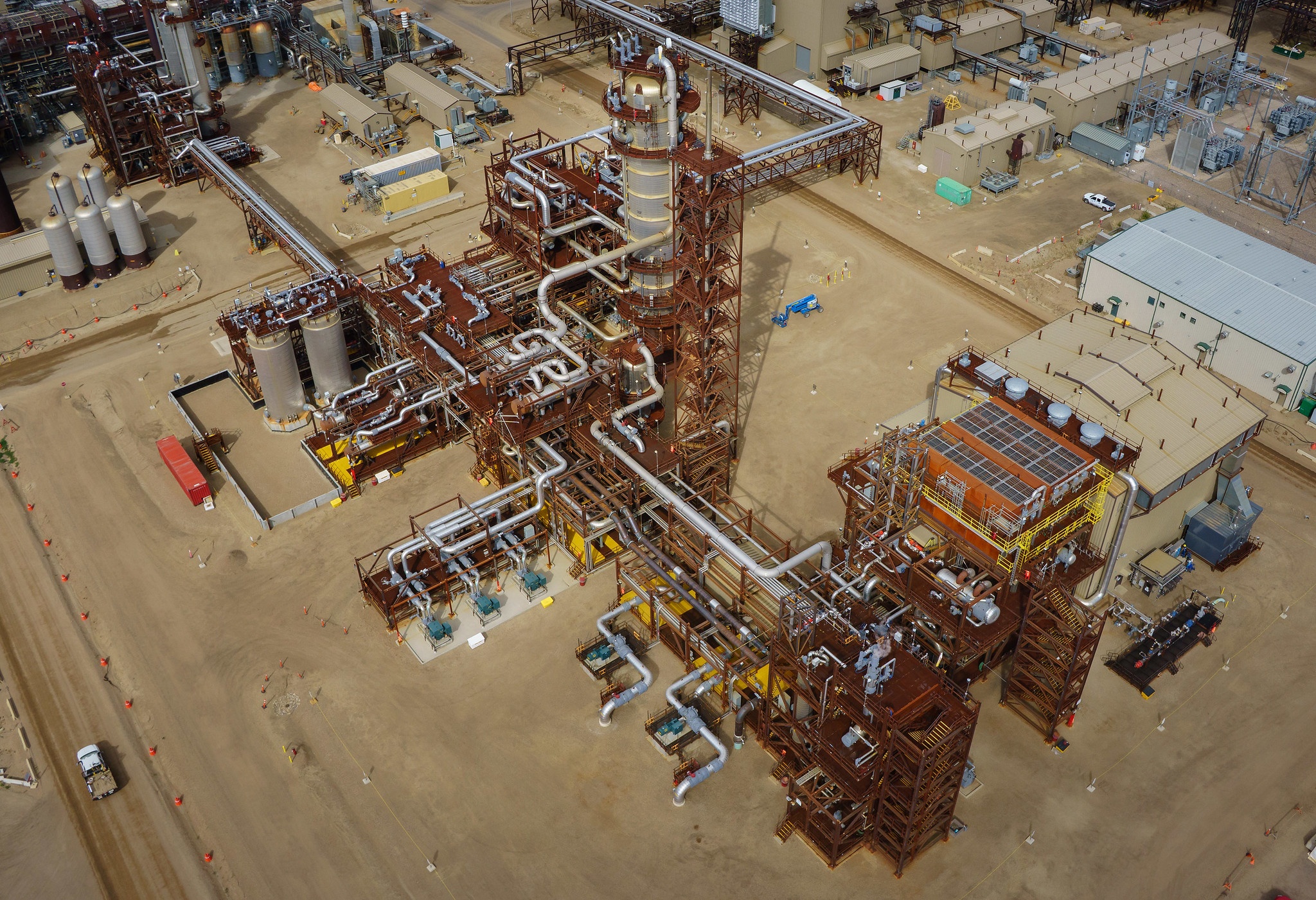We have much more to do and your continued support is needed now more than ever.
Infrastructure is Key: What’s Needed for CCUS Deployment

The latest report from the International Panel on Climate Change found that climate impacts are now widespread and severe in every part of the world. Combined with the use of other climate solutions, the deployment of carbon capture, utilization, and storage (CCUS) could help the world achieve net-zero carbon dioxide (CO2) emissions which would gradually reduce global surface temperatures.
CCUS is one of the tools in our climate solutions toolbox we need to use if we truly want to reduce emissions on an urgent but realistic timeline to protect people and wildlife. CCUS deployment means actual built infrastructure that will take up space, use resources, and require substantial investment and on-the-ground labor. Naturally, this will have impacts on land (both public and private), communities, water, wildlife, and people.
Developing a Carbon “Recycling” Economy
Responsible deployment of CCUS is necessary to reach established climate goals and protect vulnerable communities and wildlife. Carbon capture is a mitigation strategy that can be used to capture carbon dioxide emissions at their source, also referred to as “point-source capture.” Point-source carbon capture, is a strategy capturing carbon right at facilities like power plants, chemical plants, or cement production plants, which produce CO2. The processed carbon is then stored or funneled into other portions of the market for reuse, a form of carbon dioxide “recycling.”
The energy, industrial, and manufacturing sectors are particularly carbon-intensive and could see increased efficiency and reduced emissions with the deployment of CCUS technologies. For example, CCUS can be especially beneficial in the energy sector to avoid the release of carbon dioxide for newer natural gas power plants, which are likely to remain in operation for some time even as we shift toward clean energy.
The industrial sector tends to produce materials via carbon-intensive chemical reactions — this is where CCUS can be integral in drawing down those unavoidable emissions.
Research and Development
The National Wildlife Federation is calling on Congress to include substantial investments in research, development, and deployment for CCUS in the Build Back Better initiative, as this legislation combined with the Infrastructure Investment and Jobs Act will be the largest investment in infrastructure and climate policy the U.S. has seen in decades. Research and development for CCUS is crucial because the technology is still developing, and needs sustained support to fully scale to reach our climate goals. Now is the time to use every tool in the toolbox to address climate change including CCUS to protect people and wildlife.
Scaling Up Infrastructure to Meet Emissions Reduction Needs
Along with greenhouse gas reductions via clean energy, building upgrades, carbon dioxide removal, and natural carbon sequestration, CCUS is an integral part of the greenhouse gas reduction plan. Significant investment in CCUS infrastructure is necessary to get these projects up and running on a commercialized scale, so we can fully realize carbon capture’s potential.
The U.S. already has 10 large-scale carbon capture and storage facilities in operation, with a combined capacity to capture 25 million metric tons of carbon dioxide per year. For context, that’s equal to the amount of greenhouse gas emissions that would be released if about two-thirds of the American population drove passenger vehicles for one year. But if we are to meet our climate target of limiting warming to 1.5 degrees Celsius, we have to cut greenhouse gas emissions in half for the next eight years, more specifically, that means around 36 billion tons of CO2 globally. These facilities put us less than one percent of the way there.

Captured CO2 can be transported via several methods including pipelines, ship, barge, rail, and by truck. Shared pipelines, like those already used to transport oil and natural gas, will likely serve as the main method to transport captured carbon to its final destination in underground storage formations, or to enhanced oil recovery (EOR) sites where it will be used to extract hard-to-reach oil still remaining in wells, using well-established processes developed decades ago. This type of pipeline infrastructure already exists all around the world and in the U.S. Nationally, we have about 50 dedicated carbon dioxide transport pipelines that carry around 68 million metric tons of carbon dioxide per year.
While various pipeline scenarios are being explored, and some of the existing oil and gas infrastructure may be repurposed for CO2 transport, a variety of stakeholders are working to understand how many more miles of pipelines will need to be built, exactly where they might be built, or how much land they may occupy.
We do know that many facilities that employ point-source carbon capture technology (such as industrial and power plants) are not in geographically optimal storage locations, so transport pipelines are a must. Some areas in the U.S. are naturally equipped with the right underground conditions for storing liquids and gasses — factors like pore size, permeability, and more are evaluated for storage sites. This is one of the largest barriers facing CCUS deployment, which means it is also the biggest opportunity for development.
Fortunately, much of the infrastructure and processes needed for geologic storage of CO2 is already used by the oil and gas industry, which adds an element of certainty.
Understanding Storage
Carbon dioxide storage doesn’t rely on new, untested technology and carbon also naturally occurs in the environment (like any other element). Once captured and transported to its final destination, captured carbon is condensed into liquid form and injected at least 1 kilometer underground (about the length of 100 school buses lined up end to end).
At levels this deep, the earth is typically porous — those spaces are often naturally filled with salt water (what may be called a saline formation), oil, or gas. When the carbon dioxide is injected into these pores, it will displace the existing fluid, and over time the carbon dioxide may dissolve into any saline water that remains, or chemically react with reservoir rocks to form a new mineral — a process called mineralization — essentially binding the carbon dioxide into a solid form.
Any liquid or gaseous carbon dioxide will move and spread throughout the storage formation but will be kept underground by a caprock — a stronger and more impermeable material that forms a seal over the porous reservoir underneath it. Studies on geologic storage have shown that injected carbon dioxide has the potential to remain underground on the order of thousands to millions of years, and its security depends largely on the types of trapping mechanisms used, which ultimately evolve with time. The main goal of geologic storage is to permanently remove carbon dioxide from the atmosphere and ensure it isn’t reemitted — mineralization is one of the best ways science and technology has discovered to do so.
Congressional Action and Government Investment
The Infrastructure Investment and Jobs Act (Jobs Act), will help mitigate some of the challenges associated with CCUS scale-up, like subsidizing the initial cost of facility-level retrofits that may be costly and financially unattractive to owners. Money granted to the Department of Energy (DOE) would also ease the process and financial burden of building out shared regional carbon dioxide storage hubs, which is the most efficient way of transporting CO2 to optimal underground storage locations.
The Jobs Act directs a historic amount of money towards commercial-scale CCUS development and deployment via investments in carbon dioxide transportation engineering and construction, storage solutions, state-organized permitting systems, and procurement of low- and zero-carbon products made from captured carbon (like using captured carbon to make concrete).
The Build Back Better Act (BBBA), which is still being negotiated in Congress, may include upgrades to an important carbon sequestration tax credit often referred to as 45Q. The credit was originally implemented to incentivize investment in carbon capture and storage projects. However, potential upgrades within the BBBA will make it more attractive to investors. Once enacted, the credit will expand the time frame for applicable projects, make it easier for midsize and smaller facilities to qualify by reducing capture requirements for eligible facilities, increase credit amounts while continuing to prioritize carbon dioxide storage over utilization, and implement direct pay instead of costly and complicated tax equity.
Community and Wildlife Concerns about CCUS Buildout
CCUS deployment doesn’t come without concerns — after all, many technologies intended to solve a problem often bring about new challenges. So far, enhanced oil recovery (EOR) has been the primary pathway for captured carbon as it is the most lucrative market for it. Critics worry that EOR will only prolong the extraction and use of oil and gas, defeating the purpose of carbon capture in the first place.
While EOR is not the preferred pathway for captured carbon from a climate standpoint, it does result in lower life cycle emissions in oil production, and has helped to drive the development of carbon capture as an industry. With this reasoning as a springboard, advocates can fight for the kinds of upgrades to 45Q (mentioned above) that will further incentivize carbon storage instead of EOR.

Many fears surrounding carbon dioxide storage stem from concerns that the carbon dioxide will escape back into the atmosphere, either re-polluting the air or contaminating groundwater. There is also evidence to suggest that CO2 injection may increase the number of small-scale earthquakes in a region.
It is challenging to anticipate all of the community and environmental impacts of CCUS (partly due to CCUS existing mostly in the research and development phase and a lack of full life cycle assessments), but storage sites are carefully chosen and heavily monitored before, during, and after injection to make sure everything is safe.
Air and water quality
There are other impacts of CCUS deployment worth noting. Early research suggests carbon-capturing equipment may reduce the amount of criteria air pollutants escaping from power plant emissions. Alternatively, there are concerns with the use and disposal associated with chemicals used during CO2 processing and the carbon-emitting methods of CO2 transportation.
All of these considerations will likely have wildlife impacts — which is why the National Wildlife Federation advocates for the intentional and well-researched development of CCUS.
If CCUS is to be an effective climate solution, it must maximize environmental and climate benefits while minimizing harm to the environment, wildlife, and to people. CCUS infrastructure build-out will also affect communities; we need to acknowledge that questions still exist about how best to deploy this strategy without negatively impacting communities, especially frontline and fenceline communities who are highly climate-vulnerable, and often dealing with legacy pollution issues.
There is a crucial need to authentically engage communities in discussions about this technology and its deployment — this means bringing community members and local stakeholders into the fold of decision making while also developing and upholding regulatory and safety standards.





















